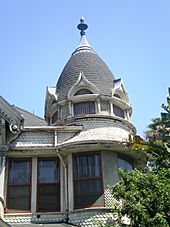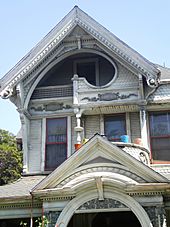Frederick Mitchell Mooers House facts for kids
|
Frederick Mitchell Mooers House
|
|

Mooers House, 2008
|
|
| Location | 818 S. Bonnie Brae St., Los Angeles, California |
|---|---|
| Built | 1894 |
| Architect | Bradbeer & Ferris architecture firm |
| Architectural style | Queen Anne-Richardsonian Romanesque-Moorish Revival-Victorian |
| NRHP reference No. | 76000489 |
Quick facts for kids Significant dates |
|
| Added to NRHP | June 3, 1976 |
The Frederick Mitchell Mooers House, also called the Wright-Mooers House, is a beautiful old home built in 1894. You can find it at 818 South Bonnie Brae Street in the Westlake area of Los Angeles, California. This house is named after Frederick Mitchell Mooers, a rich gold miner who lived there for a short time. It's a special building because it's listed as a Los Angeles Historic-Cultural Monument and is also on the National Register of Historic Places.
Contents
Discovering the Mooers House Architecture
This historic house was built during the Victorian era. It mixes different building styles. You can see parts of the Queen Anne style, which often has towers and decorative details. It also includes elements of Richardsonian Romanesque style, known for its strong, rounded arches. Plus, there are touches of Moorish Revival style, which uses designs inspired by Islamic art and architecture.
Experts David Gebhard and Robert Winter wrote a book about Los Angeles buildings. They pointed out that the house mainly looks like a Queen Anne home. However, it has small pairs of columns that show the Richardsonian Romanesque style. The tall, dome-shaped roof also gives it an Islamic or Moorish look.
Who Lived in the Mooers House?
The Wrights and Frederick Mooers
The Mooers House was first built in 1894 for May Gertrude Wright and F. L. Wright. But the Wrights sold the house in 1898. Frederick M. Mooers (1847–1900) bought it for $5,200. Mooers was known as the "Yellow Aster mining king." He is the most famous person to have lived in the house, even though he was there for less than two years. That's why the house is usually called by his name.
Mooers came from a rich family. But he loved adventure! He spent many years looking for gold in places like Montana, Wyoming, and Mexico. In 1885, he moved to Southern California. He traveled through the Mojave Desert with a pickaxe and supplies, hoping to find a big gold deposit. In 1895, he found it! Working with two partners, Mooers discovered the Yellow Aster mine in Randsburg, California. This became the richest mine in the area. Mooers became very wealthy and bought this beautiful house in a fancy Los Angeles neighborhood.
A Family Discussion Over Mooers' Estate
After Frederick Mooers passed away at age 52 in 1900, his house and all his money became part of a big family discussion. At the time, his share in the Yellow Aster Mining Company was worth a lot of money. The house on Bonnie Brae was valued at $10,000.
Before he died, Mooers had signed a new will. This will gave most of his estate to his mother and brothers. The house on Bonnie Brae was left to his mother. There was a disagreement about this will, but the family eventually settled it.
Ownership by Mooers' Mother and Brothers
The Mooers House on Bonnie Brae eventually went to Mooers' mother, Eliza A.R. Mooers. She lived there until she passed away in January 1902. After her death, her sons inherited the house.
Why the Mooers House is Historic
Even though the area around the house has changed, the Mooers House and other Victorian homes in the South Bonnie Brae Historic District have been kept in good condition. The Mooers House is often shown as a great example of Victorian architecture on the West Coast.
In 1967, the Los Angeles Cultural Heritage Commission named the Mooers House a Historic-Cultural Monument (HCM #45). It was also added to the National Register of Historic Places in 1976. A special marker at the house calls it "A Prototype of Distinctive Architecture of the Boom of the 80’s." This means it's a great example of the unique buildings from that time.






